Abstract
OBJECTIVES. Although reliable direct state and local estimates of the activity-limited population are frequently unavailable, regression-adjusted synthetic estimates can be made. Such estimates use multivariate methods to model activity limitation at the national level and then apply model-predicted probabilities to corresponding community-specific demographic data. METHODS. Using the 1989 National Health Interview Survey and the 1991 Area Resource File System, this study produced log-linear regression models that included person-level demographic and county-level contextual variables as predictors of activity limitation. Model-predicted rates were then multiplied by corresponding intercensal population data to generate state and local synthetic estimates of activity limitation. RESULTS. Rates of activity limitation generally were found to increase with age and as the socioeconomic conditions of the county in which an individual resided worsened. Race and sex also tended to be statistically significant predictors of activity limitation. CONCLUSIONS. Activity limitation can be effectively modeled by age, sex, race, and community socioeconomic status. Synthetic estimates such as these are relatively simple to generate and can be useful for small-area planning in the absence of direct local estimates.
Full text
PDF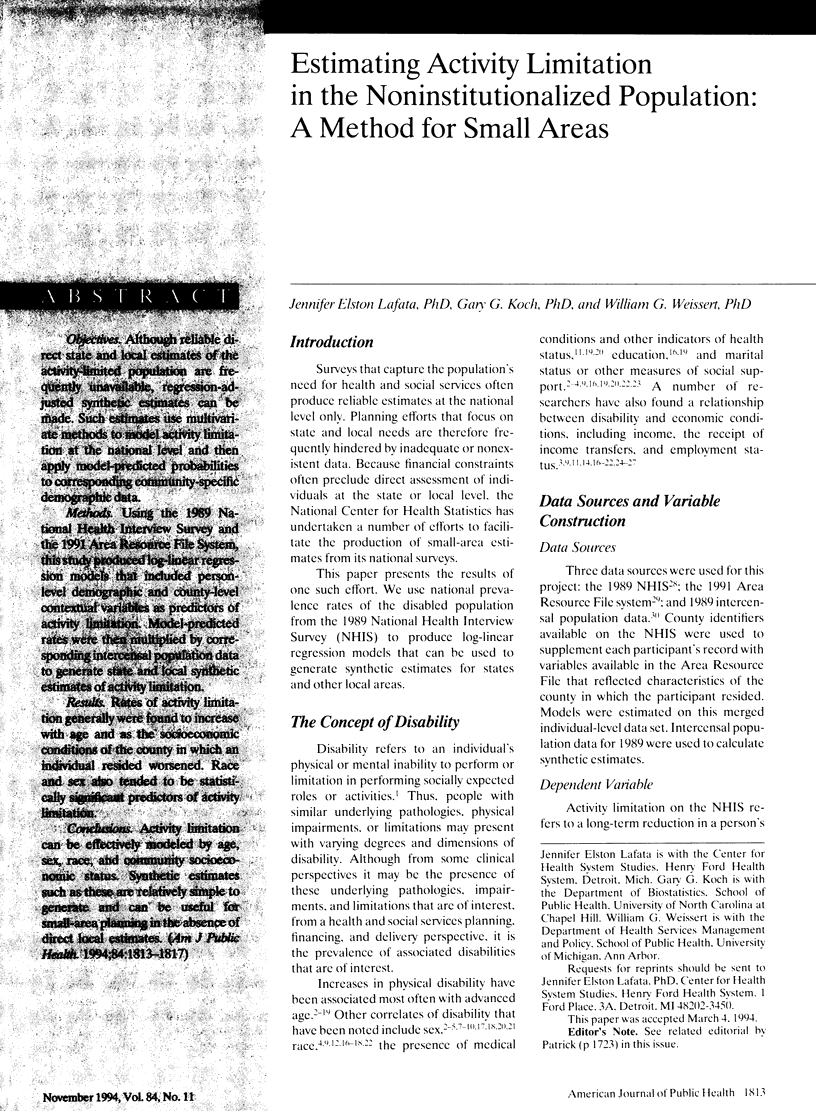
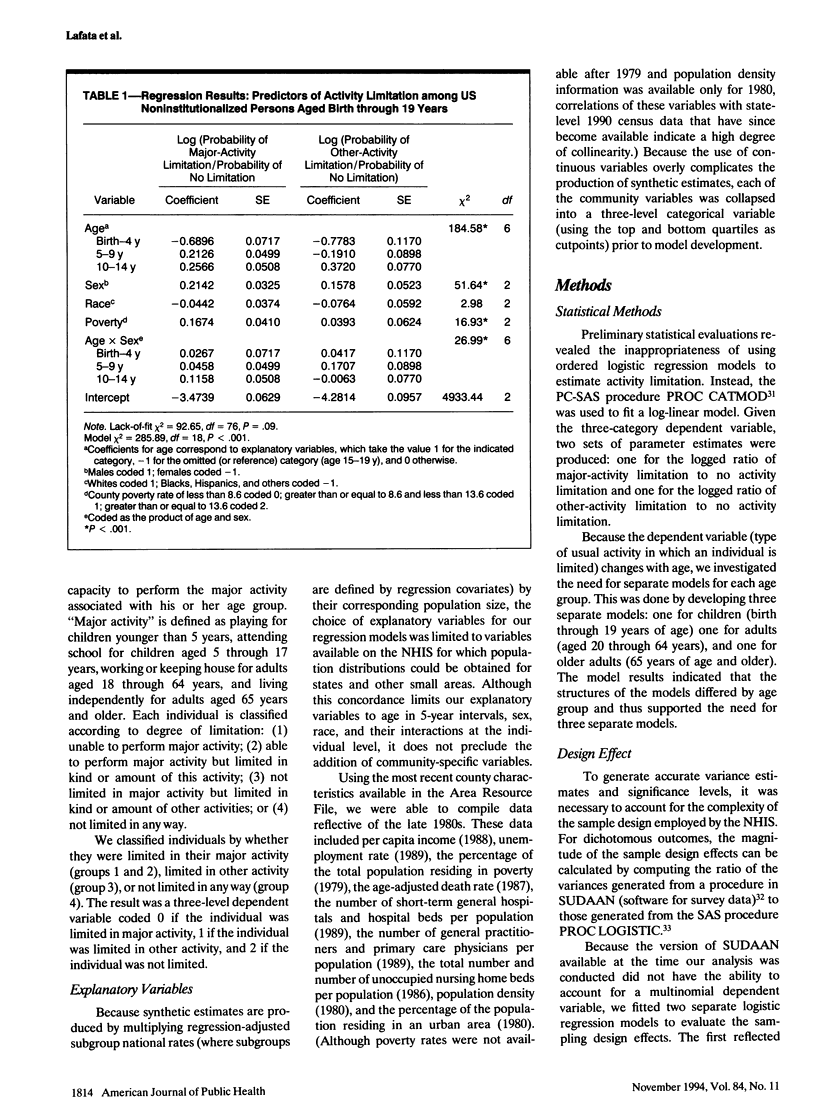
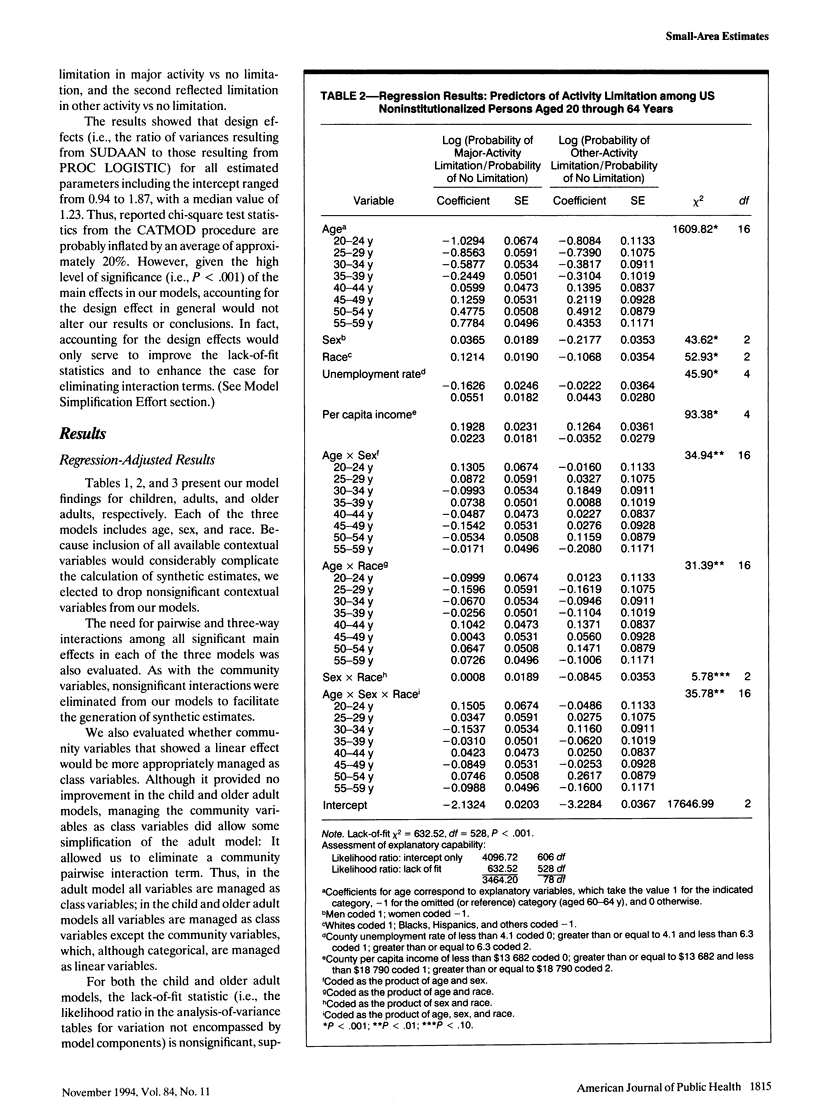
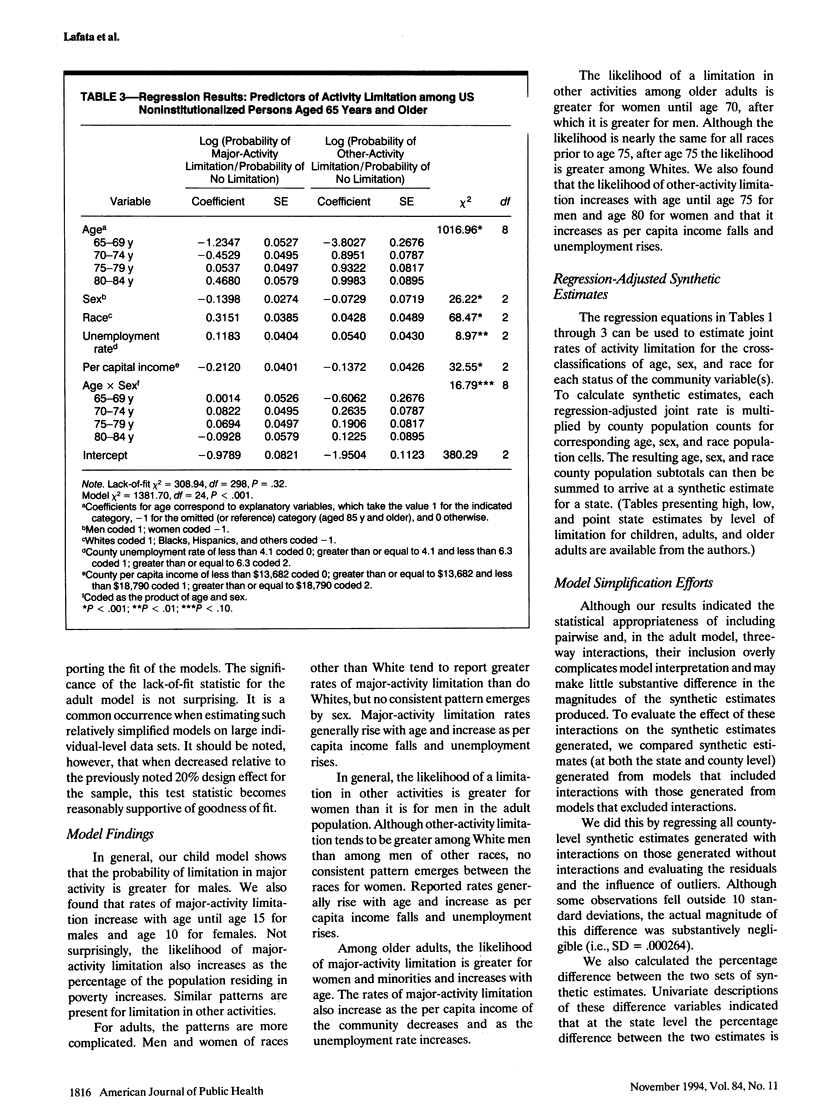
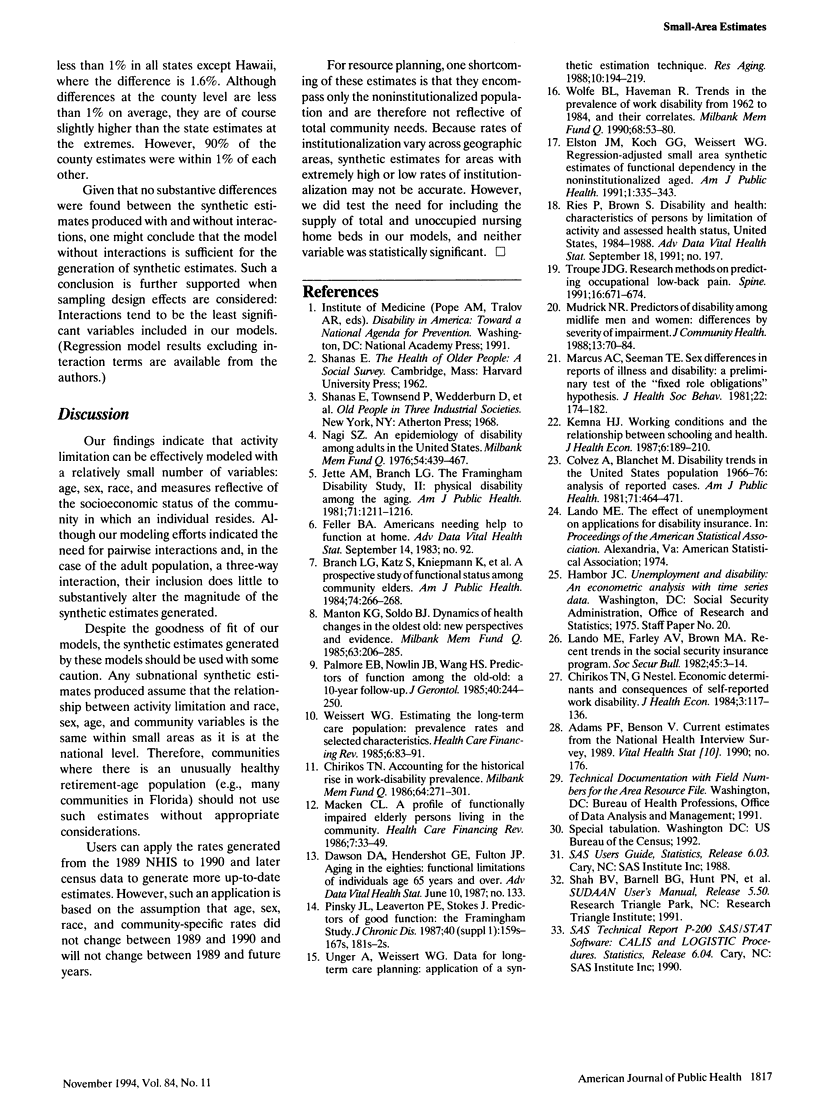
Selected References
These references are in PubMed. This may not be the complete list of references from this article.
- Branch L. G., Katz S., Kniepmann K., Papsidero J. A. A prospective study of functional status among community elders. Am J Public Health. 1984 Mar;74(3):266–268. doi: 10.2105/ajph.74.3.266. [DOI] [PMC free article] [PubMed] [Google Scholar]
- Cats-Baril W. L., Frymoyer J. W. Demographic factors associated with the prevalence of disability in the general population. Analysis of the NHANES I database. Spine (Phila Pa 1976) 1991 Jun;16(6):671–674. doi: 10.1097/00007632-199106000-00019. [DOI] [PubMed] [Google Scholar]
- Chirikos T. N. Accounting for the historical rise in work-disability prevalence. Milbank Q. 1986;64(2):271–301. [PubMed] [Google Scholar]
- Chirikos T. N., Nestel G. Economic determinants and consequences of self-reported work disability. J Health Econ. 1984 Aug;3(2):117–136. doi: 10.1016/0167-6296(84)90002-x. [DOI] [PubMed] [Google Scholar]
- Colvez A., Blanchet M. Disability trends in the United States population 1966-76: analysis of reported causes. Am J Public Health. 1981 May;71(5):464–471. doi: 10.2105/ajph.71.5.464. [DOI] [PMC free article] [PubMed] [Google Scholar]
- Elston J. M., Koch G. G., Weissert W. G. Regression-adjusted small area estimates of functional dependency in the noninstitutionalized American population age 65 and over. Am J Public Health. 1991 Mar;81(3):335–343. doi: 10.2105/ajph.81.3.335. [DOI] [PMC free article] [PubMed] [Google Scholar]
- Jette A. M., Branch L. G. The Framingham Disability Study: II. Physical disability among the aging. Am J Public Health. 1981 Nov;71(11):1211–1216. doi: 10.2105/ajph.71.11.1211. [DOI] [PMC free article] [PubMed] [Google Scholar]
- Kemna H. J. Working conditions and the relationship between schooling and health. J Health Econ. 1987 Sep;6(3):189–210. doi: 10.1016/0167-6296(87)90008-7. [DOI] [PubMed] [Google Scholar]
- Lando M. E., Farley A. V., Brown M. A. Recent trends in the Social Security Disability Insurance Program. Soc Secur Bull. 1982 Aug;45(8):3–14. [PubMed] [Google Scholar]
- Macken C. L. A profile of functionally impaired elderly persons living in the community. Health Care Financ Rev. 1986 Summer;7(4):33–49. [PMC free article] [PubMed] [Google Scholar]
- Manton K. G., Soldo B. J. Dynamics of health changes in the oldest old: new perspectives and evidence. Milbank Mem Fund Q Health Soc. 1985 Spring;63(2):206–285. [PubMed] [Google Scholar]
- Marcus A. C., Seeman T. E. Sex differences in reports of illness and disability: a preliminary test of the "fixed role obligations" hypothesis. J Health Soc Behav. 1981 Jun;22(2):174–182. [PubMed] [Google Scholar]
- Mudrick N. R. Predictors of disability among midlife men and women: differences by severity of impairment. J Community Health. 1988 Summer;13(2):70–84. doi: 10.1007/BF01364202. [DOI] [PubMed] [Google Scholar]
- Nagi S. Z. An epidemiology of disability among adults in the United States. Milbank Mem Fund Q Health Soc. 1976 Fall;54(4):439–467. [PubMed] [Google Scholar]
- Palmore E. B., Nowlin J. B., Wang H. S. Predictors of function among the old-old: a 10-year follow-up. J Gerontol. 1985 Mar;40(2):244–250. doi: 10.1093/geronj/40.2.244. [DOI] [PubMed] [Google Scholar]
- Pinsky J. L., Leaverton P. E., Stokes J., 3rd Predictors of good function: the Framingham Study. J Chronic Dis. 1987;40 (Suppl 1):159S-167S, 181S-2. doi: 10.1016/s0021-9681(87)80045-0. [DOI] [PubMed] [Google Scholar]
- Unger A., Weissert W. G. Data for long-term care planning. Application of a synthetic estimation technique. Res Aging. 1988 Jun;10(2):194–219. doi: 10.1177/0164027588102003. [DOI] [PubMed] [Google Scholar]
- Weissert W. G. Estimating the long-term care population: prevalence rates and selected characteristics. Health Care Financ Rev. 1985 Summer;6(4):83–91. [PMC free article] [PubMed] [Google Scholar]
- Wolfe B. L., Haveman R. Trends in the prevalence of work disability from 1962 to 1984, and their correlates. Milbank Q. 1990;68(1):53–80. [PubMed] [Google Scholar]


